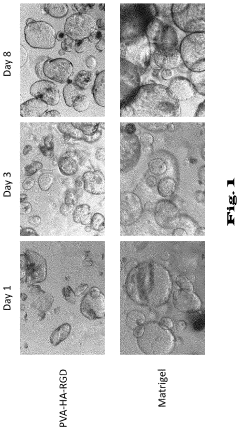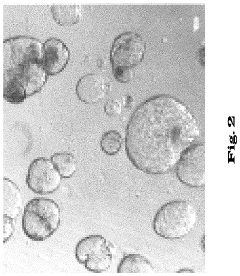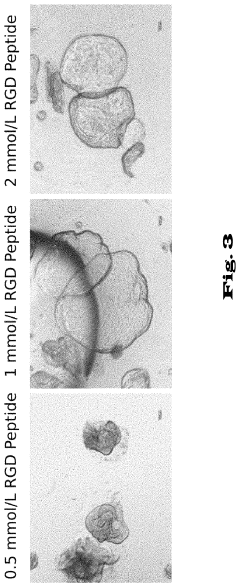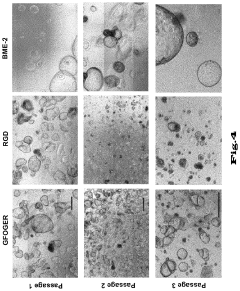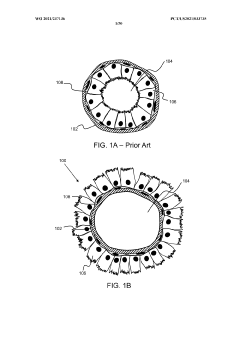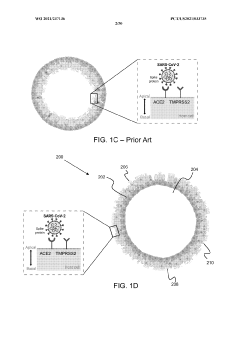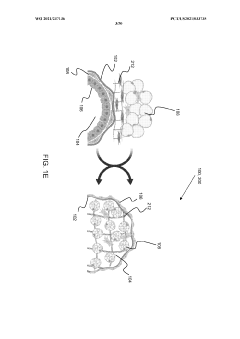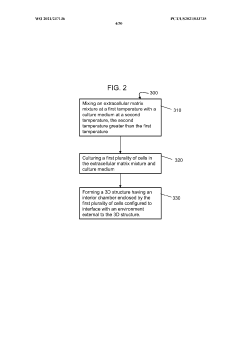Understanding Organoid Culture Systems in Biotechnology
OCT 10, 20259 MIN READ
Generate Your Research Report Instantly with AI Agent
Patsnap Eureka helps you evaluate technical feasibility & market potential.
Organoid Technology Background and Objectives
Organoid technology represents a revolutionary advancement in biotechnology, emerging from the convergence of stem cell research, developmental biology, and tissue engineering. These three-dimensional cellular structures mimic the architecture and functionality of native organs, providing unprecedented opportunities for studying human development, disease modeling, drug discovery, and regenerative medicine. The evolution of organoid technology can be traced back to the early 2000s, with significant breakthroughs occurring in 2009 when Sato and colleagues developed the first intestinal organoids from Lgr5+ stem cells.
The technological trajectory has since accelerated dramatically, with researchers successfully developing organoids representing various organ systems including brain, liver, kidney, pancreas, lung, and retina. This progression has been facilitated by advances in understanding stem cell biology, particularly the identification of specific growth factors and extracellular matrix components that guide organ-specific differentiation and self-organization.
The primary objective of organoid technology is to create physiologically relevant in vitro models that accurately recapitulate the structural and functional aspects of human organs. These models aim to bridge the gap between traditional two-dimensional cell cultures, which fail to capture the complexity of tissue architecture, and animal models, which often inadequately represent human physiology and disease processes.
Current research goals focus on enhancing the maturity and complexity of organoid systems, improving reproducibility, and developing standardized protocols for consistent generation. Significant emphasis is placed on incorporating vascular networks and immune components to better simulate the native organ microenvironment. Additionally, researchers are working toward scaling up production for high-throughput applications in drug screening and toxicity testing.
The integration of advanced technologies such as bioprinting, microfluidics, and organ-on-chip platforms represents the next frontier in organoid research, potentially enabling the creation of more sophisticated multi-organ systems. These integrated approaches aim to model complex physiological interactions between different organ systems, providing insights into systemic responses to drugs and diseases.
Long-term objectives include developing transplantable organoids for regenerative medicine applications, creating personalized disease models for precision medicine approaches, and establishing comprehensive "human-on-a-chip" systems for studying complex physiological and pathological processes. The ultimate vision is to reduce reliance on animal testing while accelerating drug development timelines and improving success rates in clinical trials through more predictive preclinical models.
The technological trajectory has since accelerated dramatically, with researchers successfully developing organoids representing various organ systems including brain, liver, kidney, pancreas, lung, and retina. This progression has been facilitated by advances in understanding stem cell biology, particularly the identification of specific growth factors and extracellular matrix components that guide organ-specific differentiation and self-organization.
The primary objective of organoid technology is to create physiologically relevant in vitro models that accurately recapitulate the structural and functional aspects of human organs. These models aim to bridge the gap between traditional two-dimensional cell cultures, which fail to capture the complexity of tissue architecture, and animal models, which often inadequately represent human physiology and disease processes.
Current research goals focus on enhancing the maturity and complexity of organoid systems, improving reproducibility, and developing standardized protocols for consistent generation. Significant emphasis is placed on incorporating vascular networks and immune components to better simulate the native organ microenvironment. Additionally, researchers are working toward scaling up production for high-throughput applications in drug screening and toxicity testing.
The integration of advanced technologies such as bioprinting, microfluidics, and organ-on-chip platforms represents the next frontier in organoid research, potentially enabling the creation of more sophisticated multi-organ systems. These integrated approaches aim to model complex physiological interactions between different organ systems, providing insights into systemic responses to drugs and diseases.
Long-term objectives include developing transplantable organoids for regenerative medicine applications, creating personalized disease models for precision medicine approaches, and establishing comprehensive "human-on-a-chip" systems for studying complex physiological and pathological processes. The ultimate vision is to reduce reliance on animal testing while accelerating drug development timelines and improving success rates in clinical trials through more predictive preclinical models.
Market Analysis for Organoid-Based Applications
The global organoid market is experiencing robust growth, valued at approximately $1.3 billion in 2022 and projected to reach $3.9 billion by 2027, representing a compound annual growth rate (CAGR) of 22.1%. This significant expansion is driven by several key factors, including increasing research activities in regenerative medicine, rising prevalence of chronic diseases, and growing adoption of personalized medicine approaches.
The pharmaceutical industry represents the largest market segment for organoid technologies, accounting for roughly 40% of the total market share. Drug discovery and toxicity testing applications are particularly prominent, as organoids provide more physiologically relevant models compared to traditional 2D cell cultures, potentially reducing the high attrition rates in drug development pipelines. Several major pharmaceutical companies have established dedicated organoid research divisions or partnered with specialized biotechnology firms to leverage this technology.
Cancer research constitutes another substantial market segment, with organoid models being increasingly utilized for patient-derived tumor modeling, precision oncology applications, and development of novel therapeutic approaches. The ability to create patient-specific tumor organoids enables more accurate prediction of treatment responses, supporting the growing trend toward precision medicine in oncology.
Regenerative medicine applications represent the fastest-growing segment, with a CAGR exceeding 25%. This includes the development of organoids for tissue replacement, disease modeling, and organ transplantation research. The potential to address organ shortage crises through organoid-derived tissues has attracted significant investment from both public and private sectors.
Geographically, North America dominates the market with approximately 45% share, followed by Europe (30%) and Asia-Pacific (20%). However, the Asia-Pacific region is expected to witness the highest growth rate over the forecast period, driven by increasing research investments in countries like China, Japan, and South Korea, along with improving healthcare infrastructure and growing awareness about advanced biotechnological applications.
Key challenges limiting market expansion include high production costs, technical complexities in maintaining consistent organoid cultures, and regulatory uncertainties surrounding clinical applications. Additionally, the lack of standardized protocols and quality control measures presents obstacles to widespread commercial adoption, particularly in clinical settings.
Emerging opportunities include the integration of organoid technology with other advanced platforms such as organ-on-chip devices, artificial intelligence for predictive modeling, and bioprinting technologies for more complex tissue construction. These convergent approaches are expected to expand the application scope and market potential of organoid-based technologies significantly in the coming years.
The pharmaceutical industry represents the largest market segment for organoid technologies, accounting for roughly 40% of the total market share. Drug discovery and toxicity testing applications are particularly prominent, as organoids provide more physiologically relevant models compared to traditional 2D cell cultures, potentially reducing the high attrition rates in drug development pipelines. Several major pharmaceutical companies have established dedicated organoid research divisions or partnered with specialized biotechnology firms to leverage this technology.
Cancer research constitutes another substantial market segment, with organoid models being increasingly utilized for patient-derived tumor modeling, precision oncology applications, and development of novel therapeutic approaches. The ability to create patient-specific tumor organoids enables more accurate prediction of treatment responses, supporting the growing trend toward precision medicine in oncology.
Regenerative medicine applications represent the fastest-growing segment, with a CAGR exceeding 25%. This includes the development of organoids for tissue replacement, disease modeling, and organ transplantation research. The potential to address organ shortage crises through organoid-derived tissues has attracted significant investment from both public and private sectors.
Geographically, North America dominates the market with approximately 45% share, followed by Europe (30%) and Asia-Pacific (20%). However, the Asia-Pacific region is expected to witness the highest growth rate over the forecast period, driven by increasing research investments in countries like China, Japan, and South Korea, along with improving healthcare infrastructure and growing awareness about advanced biotechnological applications.
Key challenges limiting market expansion include high production costs, technical complexities in maintaining consistent organoid cultures, and regulatory uncertainties surrounding clinical applications. Additionally, the lack of standardized protocols and quality control measures presents obstacles to widespread commercial adoption, particularly in clinical settings.
Emerging opportunities include the integration of organoid technology with other advanced platforms such as organ-on-chip devices, artificial intelligence for predictive modeling, and bioprinting technologies for more complex tissue construction. These convergent approaches are expected to expand the application scope and market potential of organoid-based technologies significantly in the coming years.
Current Challenges in Organoid Culture Systems
Despite significant advancements in organoid technology, several critical challenges continue to impede the full realization of organoid culture systems in biotechnology applications. One of the most persistent issues is reproducibility and standardization. Current protocols often yield organoids with considerable batch-to-batch variability, making experimental replication difficult and hindering clinical translation. This variability stems from multiple factors including heterogeneous starting materials, inconsistent extracellular matrix compositions, and undefined media components.
Matrix dependency represents another major hurdle. Most organoid cultures rely heavily on Matrigel or similar animal-derived matrices, which suffer from lot-to-batch variability, undefined composition, and potential immunogenicity concerns. These limitations not only affect experimental consistency but also create regulatory challenges for clinical applications, necessitating the development of synthetic alternatives that can provide consistent mechanical and biochemical cues.
Vascularization deficiency significantly limits organoid size and functionality. Without proper blood vessel networks, organoids typically cannot exceed 200-400 micrometers in diameter before developing necrotic cores due to insufficient nutrient and oxygen diffusion. This size limitation restricts their utility in modeling complex tissue architectures and organ-level functions, particularly for tissues with high metabolic demands.
Maturation barriers present another significant challenge. Many organoid systems fail to achieve adult-like functionality, instead remaining in a fetal or immature state. This developmental arrest limits their applicability for modeling adult diseases, drug metabolism studies, and toxicity screening. The absence of key physiological stimuli—including mechanical forces, electrical stimulation, and inter-organ communication—likely contributes to this maturation deficit.
Technical complexity and high costs associated with organoid culture systems create accessibility barriers. The specialized equipment, expensive growth factors, and technical expertise required limit widespread adoption, particularly in resource-constrained settings. Additionally, the labor-intensive nature of organoid culture and analysis increases experimental costs and reduces throughput for drug screening applications.
Microenvironmental control remains suboptimal in current systems. Precise regulation of oxygen tension, pH, nutrient gradients, and mechanical forces—all critical for proper organoid development—is difficult to achieve with conventional culture methods. This limitation affects organoid maturation, cellular organization, and functional properties, ultimately reducing their physiological relevance.
Integration challenges with existing analytical platforms further complicate organoid applications. Many established assays and imaging techniques require adaptation for 3D structures, and high-throughput screening platforms designed for 2D cultures often cannot accommodate organoid systems without significant modification, limiting their utility in drug discovery pipelines.
Matrix dependency represents another major hurdle. Most organoid cultures rely heavily on Matrigel or similar animal-derived matrices, which suffer from lot-to-batch variability, undefined composition, and potential immunogenicity concerns. These limitations not only affect experimental consistency but also create regulatory challenges for clinical applications, necessitating the development of synthetic alternatives that can provide consistent mechanical and biochemical cues.
Vascularization deficiency significantly limits organoid size and functionality. Without proper blood vessel networks, organoids typically cannot exceed 200-400 micrometers in diameter before developing necrotic cores due to insufficient nutrient and oxygen diffusion. This size limitation restricts their utility in modeling complex tissue architectures and organ-level functions, particularly for tissues with high metabolic demands.
Maturation barriers present another significant challenge. Many organoid systems fail to achieve adult-like functionality, instead remaining in a fetal or immature state. This developmental arrest limits their applicability for modeling adult diseases, drug metabolism studies, and toxicity screening. The absence of key physiological stimuli—including mechanical forces, electrical stimulation, and inter-organ communication—likely contributes to this maturation deficit.
Technical complexity and high costs associated with organoid culture systems create accessibility barriers. The specialized equipment, expensive growth factors, and technical expertise required limit widespread adoption, particularly in resource-constrained settings. Additionally, the labor-intensive nature of organoid culture and analysis increases experimental costs and reduces throughput for drug screening applications.
Microenvironmental control remains suboptimal in current systems. Precise regulation of oxygen tension, pH, nutrient gradients, and mechanical forces—all critical for proper organoid development—is difficult to achieve with conventional culture methods. This limitation affects organoid maturation, cellular organization, and functional properties, ultimately reducing their physiological relevance.
Integration challenges with existing analytical platforms further complicate organoid applications. Many established assays and imaging techniques require adaptation for 3D structures, and high-throughput screening platforms designed for 2D cultures often cannot accommodate organoid systems without significant modification, limiting their utility in drug discovery pipelines.
Current Organoid Culture Methodologies
01 3D organoid culture methods and systems
Three-dimensional organoid culture systems that mimic in vivo tissue architecture and function. These systems typically involve specialized matrices, scaffolds, or suspension techniques that allow cells to self-organize into complex structures resembling organs. The 3D environment promotes proper cell-cell interactions, differentiation, and physiological responses that are not achievable in traditional 2D cultures, making these systems valuable for studying organ development, disease modeling, and drug testing.- 3D organoid culture systems and methods: Three-dimensional organoid culture systems that mimic in vivo tissue architecture and function. These systems typically involve culturing stem cells or progenitor cells in specialized matrices that support self-organization into organ-like structures. The methods include specific growth factors, extracellular matrix components, and culture conditions that promote organoid development, enabling more physiologically relevant models for research and drug testing.
- Stem cell-derived organoid technologies: Technologies focused on generating organoids from various types of stem cells, including pluripotent stem cells, adult stem cells, and tissue-specific progenitors. These approaches involve specific differentiation protocols to direct stem cells toward particular lineages before self-organization into organoids. The technologies enable the creation of patient-specific organoids for personalized medicine applications and disease modeling.
- Organoid culture media compositions: Specialized media formulations designed to support organoid growth and development. These compositions typically contain specific combinations of growth factors, hormones, small molecules, and supplements that promote cell proliferation, differentiation, and self-organization. The media compositions are often tissue-specific and may include components that mimic the native microenvironment of the organ being modeled.
- Organoid culture devices and bioreactors: Specialized devices and bioreactor systems designed for the cultivation and maintenance of organoids. These systems provide controlled environments for organoid growth, including regulation of temperature, pH, oxygen levels, and nutrient exchange. Advanced bioreactors may incorporate perfusion systems, mechanical stimulation, or other features that enhance organoid development and functionality.
- Disease modeling and drug screening using organoids: Applications of organoid culture systems for modeling human diseases and screening therapeutic compounds. These approaches involve generating organoids from patient-derived cells or genetically modified cells to recapitulate disease phenotypes. The organoid models enable high-throughput drug screening, toxicity testing, and personalized medicine approaches by providing more physiologically relevant responses compared to traditional 2D cell cultures.
02 Stem cell-derived organoid technologies
Methods for generating organoids from various types of stem cells, including embryonic, induced pluripotent, and adult stem cells. These approaches involve specific differentiation protocols that guide stem cells to develop into organ-specific cell types and self-organize into functional tissue-like structures. The resulting organoids can recapitulate key aspects of organ development and function, providing valuable tools for regenerative medicine, personalized therapy development, and understanding developmental processes.Expand Specific Solutions03 Specialized media and growth factors for organoid cultivation
Formulations of culture media, growth factors, and supplements specifically designed to support organoid growth and development. These specialized media compositions contain precise combinations of nutrients, hormones, cytokines, and other bioactive molecules that promote cell proliferation, differentiation, and self-organization into organoids. The optimization of these culture conditions is critical for maintaining organoid viability, functionality, and physiological relevance over extended periods.Expand Specific Solutions04 Disease modeling and drug screening using organoid platforms
Applications of organoid culture systems for modeling human diseases and screening therapeutic compounds. Patient-derived organoids can recapitulate disease phenotypes, enabling the study of pathological mechanisms and personalized drug response testing. These platforms offer advantages over traditional cell culture and animal models by providing more physiologically relevant human tissue contexts for evaluating drug efficacy, toxicity, and mechanisms of action, potentially accelerating drug discovery and development processes.Expand Specific Solutions05 Bioreactors and automated systems for organoid culture
Advanced bioreactor technologies and automated systems designed specifically for large-scale, reproducible organoid culture. These systems provide controlled environments for organoid growth with precise regulation of parameters such as temperature, pH, oxygen levels, nutrient exchange, and mechanical stimulation. Automation of culture processes reduces labor requirements and variability, enabling standardized production of organoids for research and potential clinical applications such as drug screening, toxicology testing, and regenerative medicine.Expand Specific Solutions
Leading Organizations in Organoid Research
Organoid culture systems are currently in the early growth phase of industry development, with an estimated market size of $1.5-2 billion and projected strong annual growth. The technology is transitioning from research to commercial applications, with varying degrees of technical maturity across different applications. Leading players include established companies like Molecular Devices LLC and Cell Microsystems, which provide specialized equipment and platforms, alongside innovative startups such as Xilis and Organoidsciences focused on drug discovery applications. Academic institutions (Johns Hopkins University, University of Washington) continue driving fundamental research while pharmaceutical collaborations are accelerating. Companies like Chuangxin International Biotechnology and Hefei Zhongke Presheng are expanding the technology's accessibility through specialized media and reagents, indicating the field's progression toward standardization despite remaining technical challenges in scalability and reproducibility.
Cell Microsystems, Inc.
Technical Solution: Cell Microsystems has developed the CellRaft® AIR™ System, an innovative platform for isolating, culturing, and analyzing single cells and organoids. Their technology utilizes microwell arrays containing thousands of individual "CellRafts" - microscopic platforms that can be individually released and collected using automated instrumentation. This system enables researchers to establish organoid cultures from single cells with precise tracking of clonal lineages, critical for understanding organoid development and heterogeneity. The company's CytoSort® Arrays feature specialized surface coatings that promote organoid formation while allowing for non-invasive monitoring throughout the culture period. Their integrated imaging system provides automated identification of organoids based on user-defined morphological parameters, enabling selective retrieval of specific organoid phenotypes for downstream analysis. This capability is particularly valuable for isolating rare organoid subtypes or those exhibiting specific functional characteristics.
Strengths: Unparalleled single-cell to organoid tracking capability; selective retrieval of specific organoids; minimal disruption during culture monitoring; high-throughput capacity. Weaknesses: Limited scalability for large organoid production; specialized consumables required; primarily optimized for early-stage organoid development rather than long-term culture.
Molecular Devices LLC
Technical Solution: Molecular Devices has developed the ImageXpress® Micro Confocal High-Content Imaging System specifically optimized for 3D organoid imaging and analysis. Their integrated solution combines advanced imaging hardware with their proprietary MetaXpress® software to enable automated acquisition and analysis of complex organoid structures. The system features water immersion objectives that provide superior optical clarity for deep tissue imaging, critical for visualizing the internal architecture of organoids that can reach hundreds of microns in thickness. Their 3D analysis algorithms can automatically identify, segment, and quantify organoid morphology, growth patterns, and cellular composition. The company has also developed specialized microplates with optimized optical properties and surface treatments that enhance organoid formation and attachment while improving imaging quality. Their system supports live-cell imaging with environmental control, allowing researchers to monitor organoid development over extended periods.
Strengths: Industry-leading imaging resolution for 3D structures; comprehensive automated analysis workflows; integrated hardware-software solution; compatibility with various organoid types. Weaknesses: High initial investment cost; requires significant computational resources for data processing; primarily focused on imaging rather than the complete organoid culture workflow.
Key Innovations in Organoid Matrix Development
Hydrogels for cultivating pancreatic organoids
PatentInactiveUS20190367869A1
Innovation
- A chemically defined hydrogel composition with a reduced shear modulus, composed of functionalized polymer molecules and linker molecules, and low-molecular peptides with cell adhesion motifs, which allows for the cultivation and expansion of pancreatic cells into stable and functional 3D organoids without natural extracellular matrix proteins.
Stably-inverted organoids and methods of producing and using the same
PatentWO2021237136A2
Innovation
- The development of stably-inverted organoids with a hollow lumen and epithelial cells exposed to the exterior surface, allowing easier access for invasion studies, is achieved by creating a 3D structure with a tissue layer and an opposing surface where the first plurality of cells, including epithelial cells, interface with the environment externally, and an extracellular matrix mixture forms the interior chamber.
Regulatory Framework for Organoid-Based Products
The regulatory landscape for organoid-based products remains complex and evolving, reflecting the novel nature of these biotechnological innovations. Currently, organoid technologies fall under multiple regulatory frameworks depending on their intended use, with significant variations across different jurisdictions. In the United States, the FDA's regulatory approach depends on whether organoids are classified as medical devices, biological products, or combination products, with oversight divided between the Center for Biologics Evaluation and Research (CBER) and the Center for Devices and Radiological Health (CDRH).
The European Medicines Agency (EMA) has established specific guidelines for advanced therapy medicinal products (ATMPs), which often encompass organoid-based technologies. These guidelines address quality control, safety assessment, and clinical trial design considerations unique to organoid systems. Japan's regulatory framework, following the implementation of the Act on the Safety of Regenerative Medicine, offers an accelerated approval pathway that may benefit organoid-based therapies through conditional and time-limited approvals.
Ethical considerations significantly influence regulatory decisions, particularly regarding the source of cells used in organoid development. Human embryonic stem cell-derived organoids face stricter regulatory scrutiny compared to adult stem cell-derived alternatives. Informed consent protocols for tissue donation have been enhanced to specifically address the unique implications of organoid development, including potential commercialization and long-term storage of derived tissues.
Data standardization represents a critical regulatory challenge, as validation metrics for organoid systems remain inconsistent across laboratories and applications. Regulatory bodies are increasingly demanding standardized protocols for organoid generation, characterization, and quality control to ensure reproducibility and reliability in both research and clinical applications.
Privacy concerns related to genetic information contained within patient-derived organoids have prompted regulatory requirements for enhanced data protection measures. Some jurisdictions now mandate specific consent procedures for genetic analysis of organoid systems and impose restrictions on data sharing across international boundaries.
Looking forward, regulatory frameworks are expected to evolve toward a risk-based approach that considers both the source of organoid cells and their intended application. International harmonization efforts, led by organizations such as the International Council for Harmonisation (ICH), aim to develop consistent global standards for organoid-based products, potentially streamlining approval processes across major markets while maintaining rigorous safety standards.
The European Medicines Agency (EMA) has established specific guidelines for advanced therapy medicinal products (ATMPs), which often encompass organoid-based technologies. These guidelines address quality control, safety assessment, and clinical trial design considerations unique to organoid systems. Japan's regulatory framework, following the implementation of the Act on the Safety of Regenerative Medicine, offers an accelerated approval pathway that may benefit organoid-based therapies through conditional and time-limited approvals.
Ethical considerations significantly influence regulatory decisions, particularly regarding the source of cells used in organoid development. Human embryonic stem cell-derived organoids face stricter regulatory scrutiny compared to adult stem cell-derived alternatives. Informed consent protocols for tissue donation have been enhanced to specifically address the unique implications of organoid development, including potential commercialization and long-term storage of derived tissues.
Data standardization represents a critical regulatory challenge, as validation metrics for organoid systems remain inconsistent across laboratories and applications. Regulatory bodies are increasingly demanding standardized protocols for organoid generation, characterization, and quality control to ensure reproducibility and reliability in both research and clinical applications.
Privacy concerns related to genetic information contained within patient-derived organoids have prompted regulatory requirements for enhanced data protection measures. Some jurisdictions now mandate specific consent procedures for genetic analysis of organoid systems and impose restrictions on data sharing across international boundaries.
Looking forward, regulatory frameworks are expected to evolve toward a risk-based approach that considers both the source of organoid cells and their intended application. International harmonization efforts, led by organizations such as the International Council for Harmonisation (ICH), aim to develop consistent global standards for organoid-based products, potentially streamlining approval processes across major markets while maintaining rigorous safety standards.
Ethical Implications of Organoid Research
The ethical landscape surrounding organoid research presents complex challenges that require careful consideration as this biotechnology field advances. Organoids, as three-dimensional cellular structures that mimic organ functionality, raise profound questions about the moral status of these entities. While they lack consciousness and sentience in their current form, their increasing complexity and functionality blur traditional boundaries between cell cultures and embryonic tissue.
Consent and ownership issues constitute a primary ethical concern. When organoids are derived from patient tissues, questions arise regarding appropriate informed consent processes. Patients must understand not only immediate research applications but also potential future uses, commercial developments, and data sharing implications. The concept of tissue ownership becomes particularly contentious when organoids derived from a patient's cells are patented or commercialized.
Privacy considerations emerge as organoids can reveal sensitive genetic information about donors. Brain organoids present especially challenging questions, as they potentially develop rudimentary neural activity that, while far from consciousness, raises questions about appropriate research boundaries and regulatory frameworks. The scientific community must establish clear guidelines regarding the acceptable complexity of neural organoids.
The therapeutic promise of organoids introduces questions of equitable access. As organoid technologies transition from research tools to clinical applications, ensuring fair distribution of these potentially life-saving technologies across socioeconomic divides becomes imperative. Current biotechnology commercialization patterns suggest risks of creating two-tiered access systems that exacerbate existing healthcare inequalities.
Cultural and religious perspectives on organoids vary significantly, with some traditions expressing concerns about the creation of entities that mimic human development. These perspectives must be respected through inclusive stakeholder engagement in policy development. International harmonization of ethical standards presents another challenge, as regulatory approaches to organoid research differ substantially across jurisdictions.
Looking forward, proactive ethical governance frameworks are essential. These should balance scientific progress with appropriate safeguards, incorporate diverse perspectives, and remain adaptable to technological developments. The establishment of specialized ethics committees with interdisciplinary expertise could provide ongoing guidance as organoid technologies continue to evolve in complexity and application scope.
Consent and ownership issues constitute a primary ethical concern. When organoids are derived from patient tissues, questions arise regarding appropriate informed consent processes. Patients must understand not only immediate research applications but also potential future uses, commercial developments, and data sharing implications. The concept of tissue ownership becomes particularly contentious when organoids derived from a patient's cells are patented or commercialized.
Privacy considerations emerge as organoids can reveal sensitive genetic information about donors. Brain organoids present especially challenging questions, as they potentially develop rudimentary neural activity that, while far from consciousness, raises questions about appropriate research boundaries and regulatory frameworks. The scientific community must establish clear guidelines regarding the acceptable complexity of neural organoids.
The therapeutic promise of organoids introduces questions of equitable access. As organoid technologies transition from research tools to clinical applications, ensuring fair distribution of these potentially life-saving technologies across socioeconomic divides becomes imperative. Current biotechnology commercialization patterns suggest risks of creating two-tiered access systems that exacerbate existing healthcare inequalities.
Cultural and religious perspectives on organoids vary significantly, with some traditions expressing concerns about the creation of entities that mimic human development. These perspectives must be respected through inclusive stakeholder engagement in policy development. International harmonization of ethical standards presents another challenge, as regulatory approaches to organoid research differ substantially across jurisdictions.
Looking forward, proactive ethical governance frameworks are essential. These should balance scientific progress with appropriate safeguards, incorporate diverse perspectives, and remain adaptable to technological developments. The establishment of specialized ethics committees with interdisciplinary expertise could provide ongoing guidance as organoid technologies continue to evolve in complexity and application scope.
Unlock deeper insights with Patsnap Eureka Quick Research — get a full tech report to explore trends and direct your research. Try now!
Generate Your Research Report Instantly with AI Agent
Supercharge your innovation with Patsnap Eureka AI Agent Platform!
